Scotland’s Seaweed Showdown
It’s locals versus industry in the country’s kelp wars.
Article body copy
Local legend has it that Beinn Ghobhlach mountain in the Scottish Highlands was once home to a witch. Resentful of sharing the area with people, she planned to cast a spell that would destroy the surrounding forests, making the land uninhabitable. Before she could unleash the destruction, an enraged god used his sword to split her and the mountain in half, saving the forests and the people who relied on them.
Beinn Ghobhlach’s distinctive double peak sits on the Scoraig peninsula, which forms a barrier between two long, narrow lochs that cut into the jagged west Highlands coastline. This far north, in the region of Wester Ross, it is still bracingly cold in late spring. Among the wildest places left in Britain, it feels intact and unspoiled by humans.
But in reality, it is far from intact. Despite the protective rage of the god in the story, Wester Ross and the rest of the Highlands have seen rampant deforestation. Overfishing obliterated herring in the lochs decades ago. White-tailed eagles went extinct in Scotland by 1916. Lynxes, wolves, and wild boars are long gone. Even the language has stared down extinction—just over one percent of Scotland’s people speak Gaelic.
Scotland’s final truly untouched wilderness is underwater: the huge kelp forests that border the Highlands and surrounding islands. On a crisp May morning, Ailsa McLellan takes me to visit them.
A tornado of yellow and blue—hair, eyes, jacket, boots—McLellan’s vivid colors seem of a piece with the blue sea and bright-green algae covering the rocks of her home coastline. She grew up by the ocean a few hours south of Wester Ross, learning from her parents to pick seaweed for food and garden fertilizer. These days, McLellan lives near Ullapool, a small village on the shore of one of the lochs around the Scoraig peninsula. When the tides are in her favor, she drives 40 minutes to uninhabited Garvie Bay, where she has a license to harvest seaweed for small-scale commercial use.
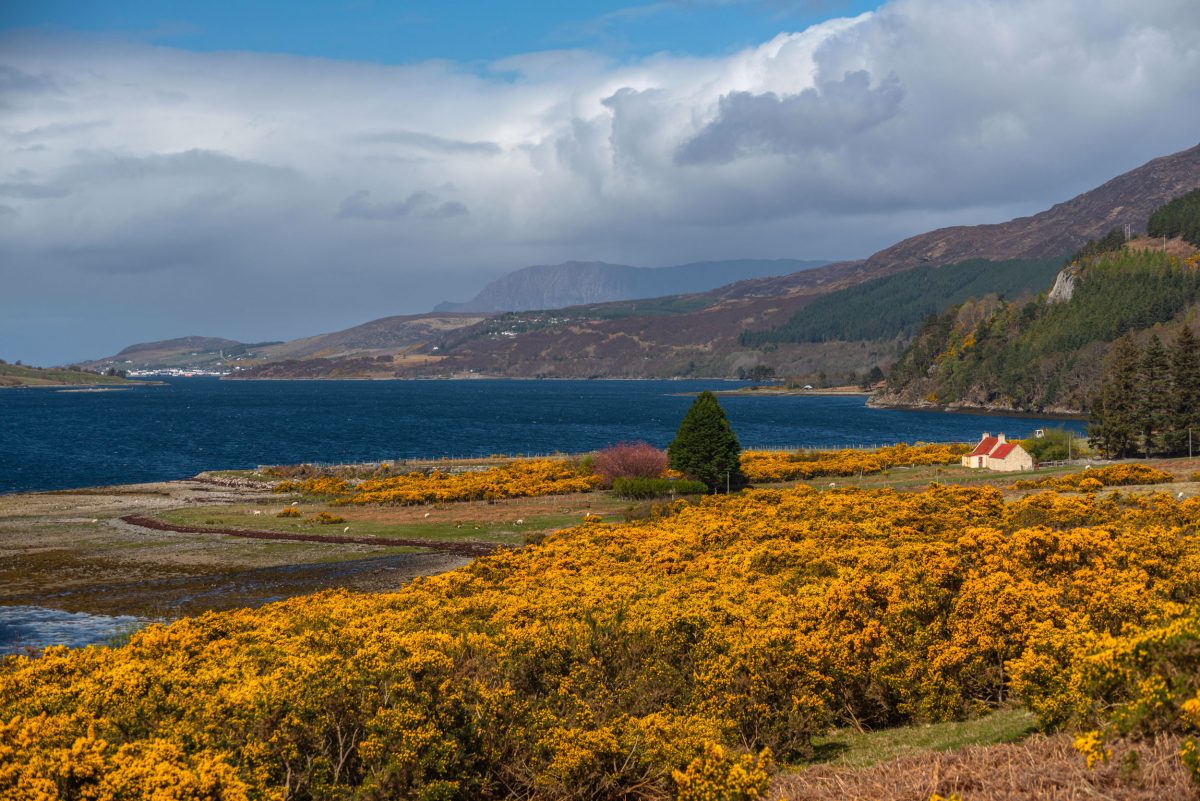
The vibrant yellow blooms of gorse line the hillsides near Ullapool, Scotland. Photo by Tillman Schlageter/Alamy Stock Photo
On the drive out to the bay, every turn brings a new view of the ocean, mottled navy and turquoise. The craggy islands of the Outer Hebrides loom on the horizon. Golden gorse bushes flank the road, filling the air with a buttery peach smell. “There’s a saying in Scotland that when there aren’t any gorse flowers, there’s no kissing. Or something like that,” McLellan tells me. Fortunately for locals, “the gorse flowers all year up here.”
Garvie Bay is an excellent spot for seaweeds. They coat the intertidal rocks in purple, brown, and near-fluorescent green. McLellan sells some of the seaweeds dried and coarsely ground into chunks as snacks or flavorful additions to soups and stews; others she sells fresh to seafood companies that supply restaurants. But lately, the tangles of kelp that darken the water below the tideline have been commanding her attention for different reasons.
In August 2018, a Scottish company called Marine Biopolymers proposed the first-ever industrial-scale harvest of kelp from Scotland’s wild and watery forests—including those here at Garvie Bay. The company argues that because kelp regrows quickly, the project would be an eco-friendly economic boon.
But kelp plays a crucial role in the environment, providing food and habitat to commercially important species like cod and lobster as well as the charismatic otters and seals that draw tourists to the Highlands, among other ecological benefits. Coastal community groups, environmentalists, and fishing industry organizations aligned against Marine Biopolymers’ proposal.
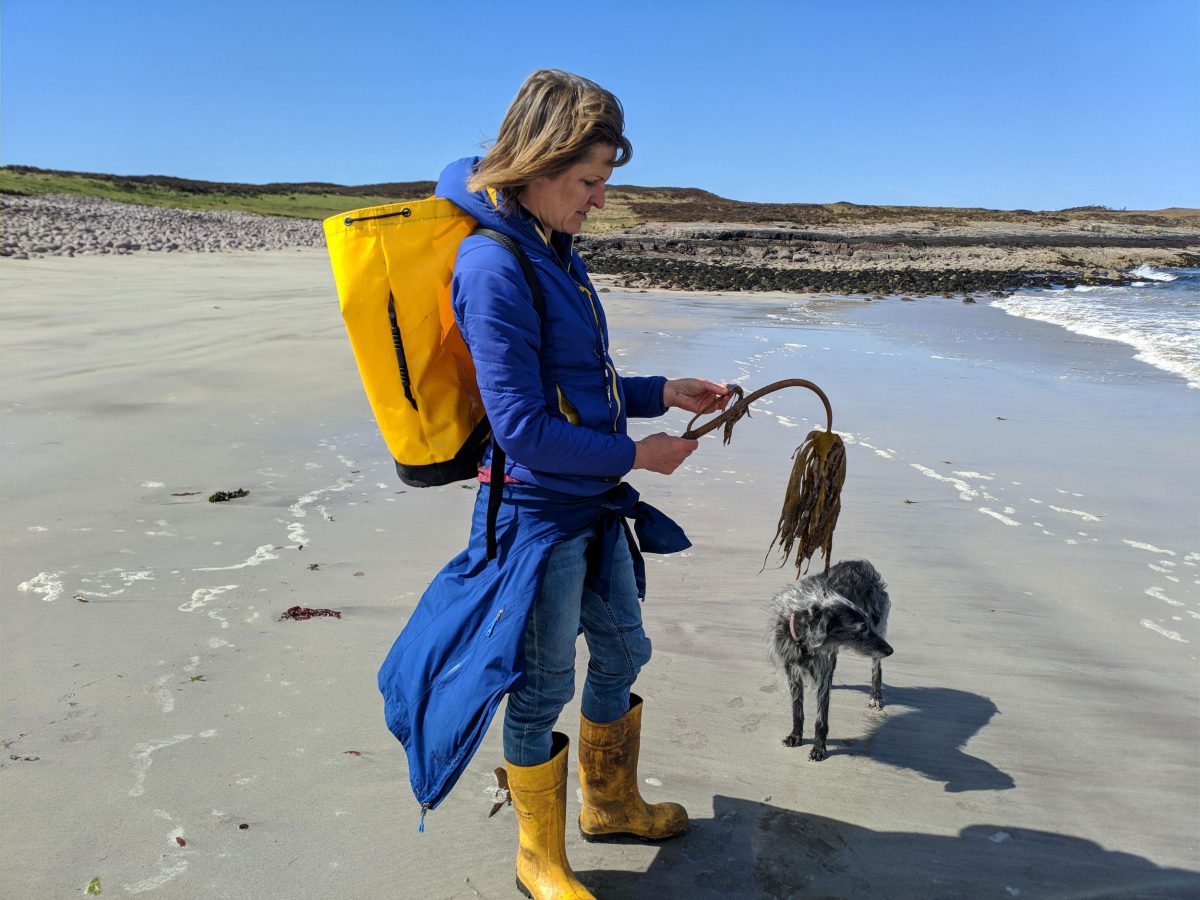
Ailsa McLellan on the beach at Garvie Bay, Scotland, where she harvests seaweeds. Photo by Cathleen O’Grady
McLellan is one of their standard-bearers: she led the opposition’s social media campaign and started a petition that racked up over 26,000 signatures. She is worried that industrial harvesting would open the door to potentially massive collateral damage. And with the world’s kelp forests facing a range of anthropogenic threats, from pollution to climate change, the sustainability of an industrial harvest is far from clear cut.
The kelp forests that Marine Biopolymers was proposing to dredge have been there for thousands of years untouched, McLellan argues. “Imagine a kelp dredger going up and down in there,” she says, gesturing at the water. “I actually couldn’t bear it.”
Had McLellan and I slipped below the waves, the murky forests we glimpsed from shore would spring to life. Kelp washed up on the beach is sticky and brown, but in sunlit water it glows as gold as the gorse.
The species at the center of Scotland’s kelp controversy is Laminaria hyperborea. People sometimes call it cuvie or tangle, but they often refer to it as just hyperborea. Unlike the seaweeds coating Garvie Bay’s rocky shore, it prefers deeper waters that cover it even at low tide. The mottling of the ocean hints at its ubiquity—the turquoise patches overlay bare sand; the navy patches are thick with kelp.
This giant alga—not a plant, although it resembles one—grows from rootlike holdfasts that clutch the rocks. Its central stalks, called stipes, can stretch much taller than a human and are topped by long fronds, forming a canopy that whips back and forth in turbulent water like branches in a blustery wood. Small fish flit through the chaos. Iridescent purple Irish moss clings to the underwater rocks gripped by the kelp holdfasts, and creatures like blue-rayed limpets cling to the kelp.
Hyperborea can live for more than a decade. Its role in the ocean resembles that of forests on land: kelp forests teem with life, from tiny invertebrates that live on holdfasts and stipes to larger animals that feed on this seaweedy buffet. The thickets shelter young sea creatures and form the foundation of a food web that sustains otters, seals, porpoises, and seabirds—as well as fish that feed humans. And like terrestrial forests, kelp forests shape their landscape: they buffer the force of turbulent ocean waves, protecting the coast against erosion, storm surges, and flooding.
Seaweed has long been a direct part of the Scottish economy as well. In the 17th and 18th centuries, several kinds were burned to produce sodium carbonate, or kelp ash, for making soap and glass. These days, the industry is mostly made up of small-scale hand harvesters like McLellan.
But interest in Scotland’s seaweed has ramped up. In 2016, the Scottish government committed to setting guidelines for a large-scale kelp harvest, even as it examined the environmental pitfalls. In 2018, a different government agency explored whether kelp could offer an opportunity for Highlands fishermen to diversify their inherently unstable businesses as major fish stocks face the threat of collapse.
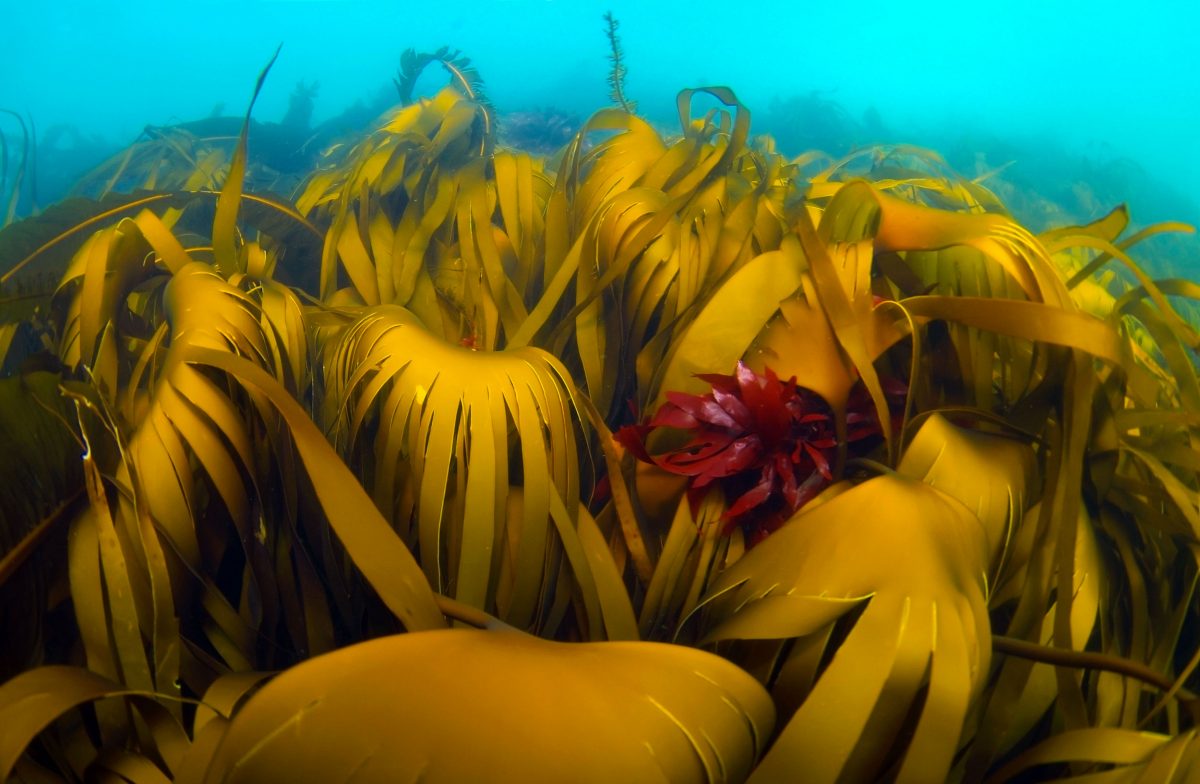
Forests of Laminaria hyperborea and other kelps provide habitat for a myriad of marine creatures. Photo by Andrey Nekrasov/Alamy Stock Photo
Eager to capitalize on the opportunities offered by seaweed, Marine Biopolymers set its sights on the Highlands’ plentiful hyperborea. Some seaweeds store a gooey substance called alginate, which has a range of industrial applications, including stabilizers in beer foam and heartburn medication. Different alginates have different uses, and China dominates the market for many types. But hyperborea, which produces a high-quality alginate with unique properties that make it particularly good at forming a gel, grows only in the North Atlantic, where Norway is its main harvester. Marine Biopolymers hoped to edge in with a new process for extracting alginate from hyperborea, while producing other useful industrial substances from what would otherwise be waste.
The company planned to apply the Norwegian harvesting method, using a comblike device called a kelp dredge to yank the kelp out whole rather than cutting it like wheat. Because of the spacing of its teeth, and the half meter it hovers above the seabed, the dredge is designed to snag mature kelp, holdfast and all, but leave juvenile kelp intact. New kelp colonizes the patches of bare rock more quickly than it would if the holdfasts were left to rot.
Scotland’s waters hold an estimated 20 million tonnes of hyperborea. Over seven years, Marine Biopolymers planned to harvest 125,700 tonnes—around six hectares for every 1,000. Each year, they planned to take less than a severe storm might remove, according to the company.
Before applying for a license, Marine Biopolymers needed to file a report with the government explaining what questions they would address in a formal study of the project’s environmental impacts and open that report to public comment and government feedback. So, in July 2018, the company published a scoping report about the proposal, which included leaving harvested patches alone for five years. Research from Norway suggests that this time frame allows kelp to recover its density and size. That, combined with the relatively small harvest, makes the process sustainable, says Sandy Dobbie, chairman of Marine Biopolymers. “Norway demonstrates that to us.”
The backlash that followed the report took the company by surprise. They have been miscast as “millionaires in suits,” Dobbie says. “We’re just a small team of Scottish scientists and engineers under attack from environmental organizations with an agenda.”
The environmentalists’ outcry against kelp dredging was particularly loud in Ullapool, a community whose engagement in environmental issues is visible at every turn. The long finger of Loch Broom, which separates the village from the Scoraig peninsula, is within a marine protected area. Café and pub bathroom posters describe how flushed wipes and cotton swabs end up in the ocean, and restaurants don’t offer plastic straws. Signs ask drivers to watch out for rare red squirrels—a species nearly ousted from Britain by invasive North American gray squirrels.
The squirrel signs are the work of the Ullapool Sea Savers, an environmental group led by children—and facilitated by adults—with a track record of successful activism. When the kelp dredge proposal emerged, the Sea Savers joined the opposition. But it wasn’t just environmentalists protesting.
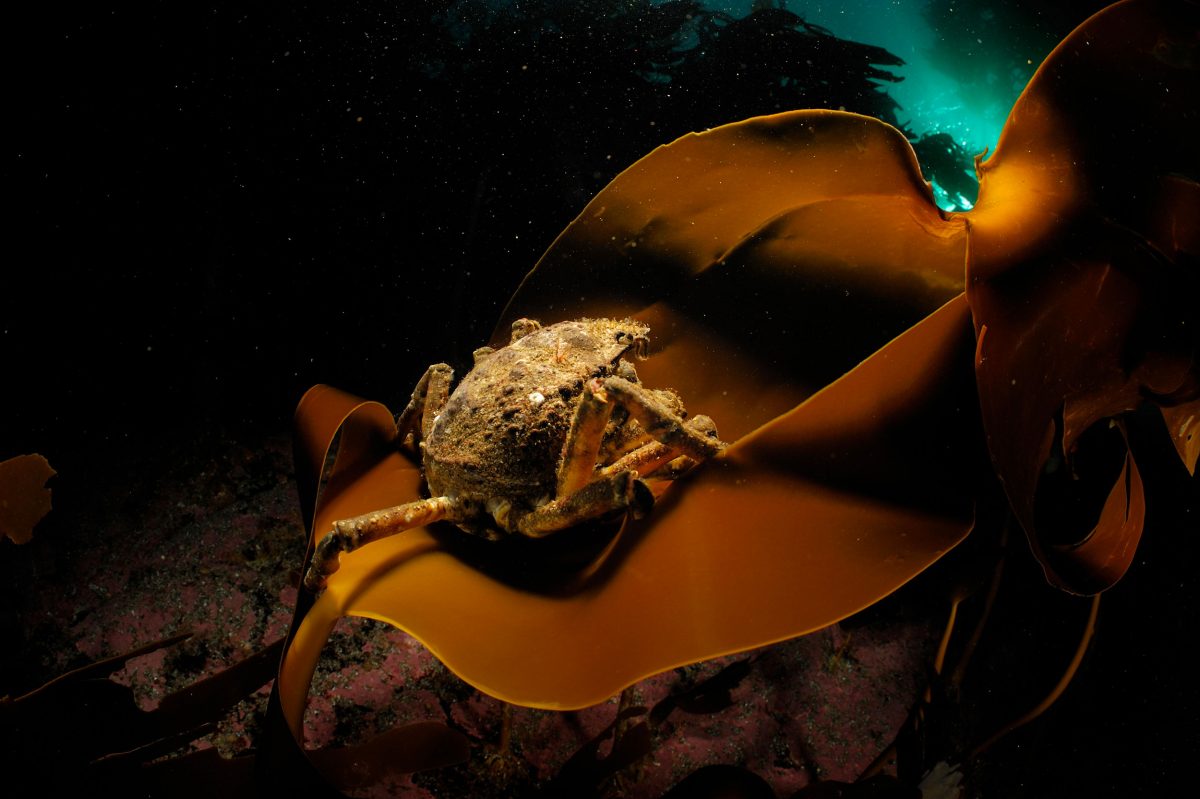
The great spider crab is one species that finds food and shelter in Atlantic Ocean kelp forests. Photo by Nature Picture Library/Alamy Stock Photo
Marine Scotland, the branch of the civil service that manages marine licensing, received an avalanche of critical responses to Marine Biopolymers’ scoping report. “We understand that the potential for employment in fragile areas is of course a benefit of the proposal,” the Clyde Fishermen’s Association wrote, “but we remain unconvinced that the potential harm to wild fisheries would be worth the trade-off.”
More than 80 fishing and tourism businesses signed an open letter asking the Scottish government to refuse to grant a license. A coalition of grassroots organizations that aims to represent the voices of community members on questions of marine management also responded with alarm. Even famed television naturalist David Attenborough came out against the project.
Objections pointed out that kelp benefits not just ecosystems, but also people directly by gobbling atmospheric carbon and protecting against coastal erosion. They also rejected the idea that industrial harvesting was anything like a storm, even if the quantities of kelp torn free are comparable. Storms are likely to remove the weakest individuals, while industrial harvesting is less discriminating. And kelp in some areas faces little natural disturbance, which means that pulling it might disrupt established local ecosystems in ways they’re not adapted to withstand.
Some places could see heavier impacts for other reasons, too. In certain harvest blocks, Marine Biopolymers planned to take up to 15 percent of kelp in a year. The impact this would have on nearby fishing businesses is unknown—both from the lost habitat itself, and from potential disturbance to the surviving forests caused by the dredging vessels and newly dredged patches of forest. A dredging block in the neighborhood could be a serious concern “if you’re the one that fished there or lived next to it,” says McLellan, who has worked in marine science and fisheries management for nearly 20 years.
Back at Garvie Bay, McLellan looks out over the dappled sea. Her own license to harvest here is restrictive, specifying that she must cut kelp in ways that allow individual alga to regenerate, leaving the holdfast, stipe, and part of the frond. “I’ve got to record every single invertebrate by-catch,” she adds, “which is no problem. Because I’m cutting it by hand, I can flick it back into the sea.”
But McLellan’s license, which limits her to just 500 kilograms of seaweed per year, is a small-scale permit. Industrial dredging wasn’t on the radar when these rules were established and would need new rules allowing holdfasts to be uprooted and by-catch to be ignored. McLellan is deeply worried that changing regulations to accommodate one industrial operation will open the door to more prospectors, something she argues Scotland’s kelp forests couldn’t withstand.
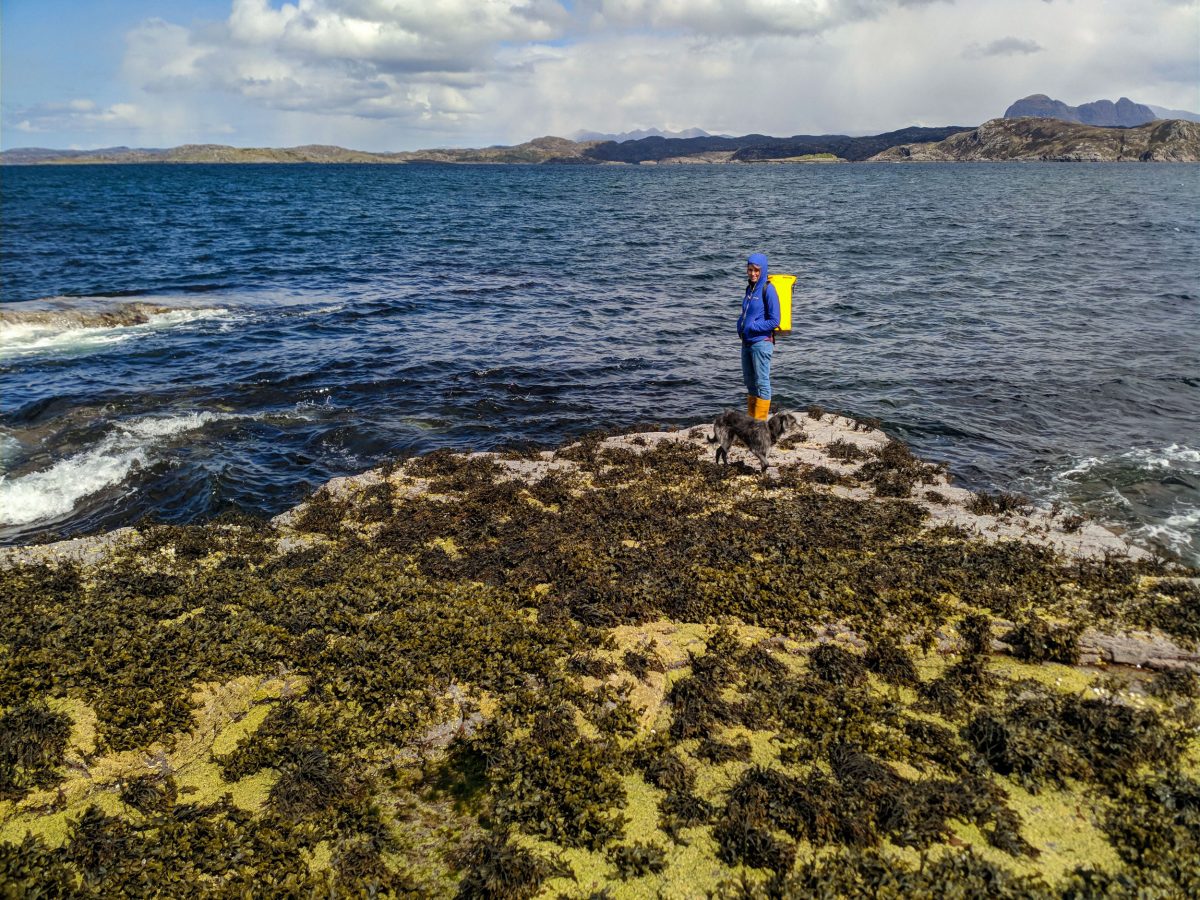
Ailsa McLellan stands on the shore of Garvie Bay, where she selectively harvests seaweed by hand. McLellan and others are concerned about a proposal for a large-scale commercial seaweed harvest in Garvie Bay and elsewhere along the Scottish coastline. Photo by Cathleen O’Grady
As she leaps over slippery rocks, yellow bucket strapped to her back, McLellan hands me different species of seaweed to taste. Pepper dulse is, as its name suggests, a little fiery; crunchy sea spaghetti reminds me of snap peas. As eager as McLellan is to share this place and its flavors, defending it for months has come at a steep personal cost. “I made myself ill fighting this campaign,” she tells me. “I had a really physical response to the stress of it.”
At the heart of the battle is deep disagreement about what “sustainable harvest” means. Marine Biopolymers’ version involves waiting until there’s enough resource regrown for more harvest. McLellan’s and other opponents’ versions involve a kelp forest that thrives as if never harvested, supporting its full complement of creatures and the businesses and communities that rely on it.
The problem is that, regardless of core values, no one actually knows what dredging’s effects here would be. There’s a dearth of information on Britain’s kelp, says ecologist Dan Smale, making it nearly impossible to judge impacts. But Smale’s work may help.
Smale’s lab is based at the Marine Biological Association in Plymouth, England, a fortress of a structure overlooking a yacht-speckled harbor. When Smale returned to England after working in Antarctica and Australia, he was surprised to discover that research on North Atlantic kelp lagged behind that on kelp elsewhere. So in 2014, he teamed up with other researchers to fill in the blanks. One of the studies they undertook was unintentionally prescient to Scotland’s fight: examining how hyperborea responds to disturbances like storms, sea urchin grazing, and harvesting.
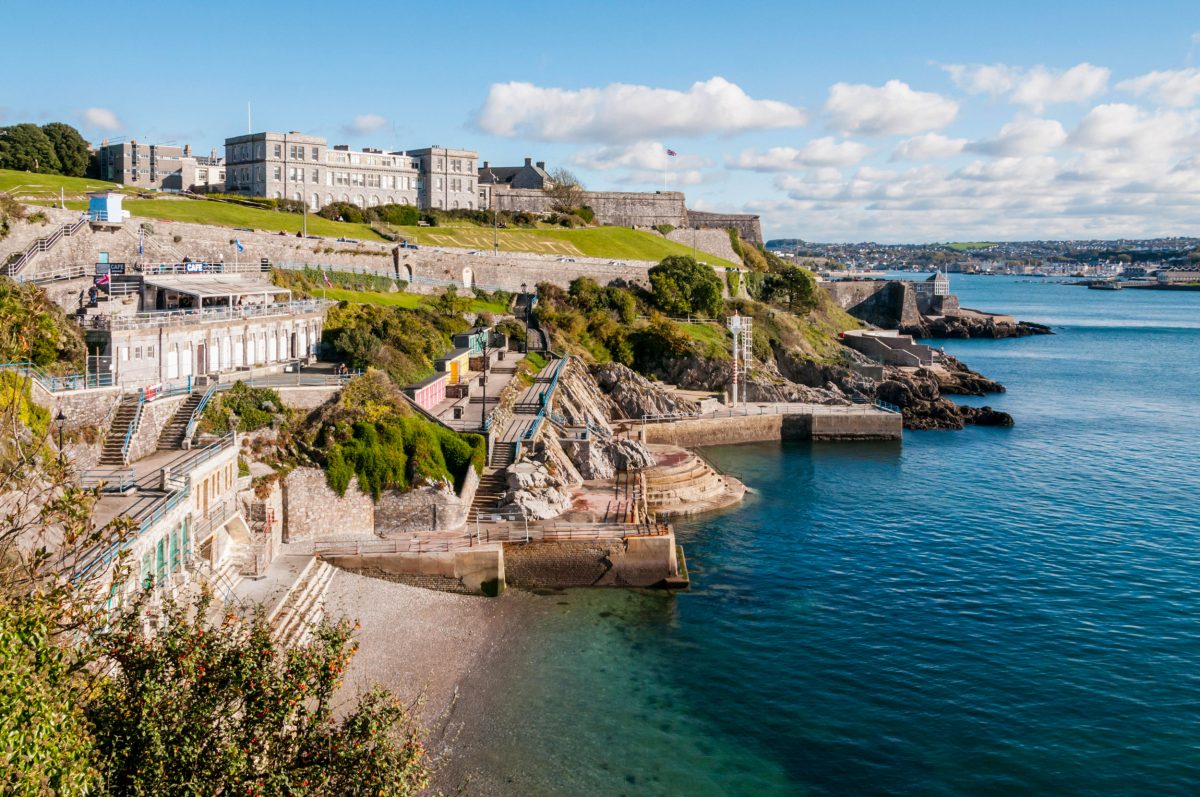
The Marine Biological Association’s lab in Plymouth, England. Photo by UrbanImages/Alamy Stock Photo
Hyperborea’s range stretches from northern Norway and Iceland as far south as Portugal, and the forests across this range differ dramatically. Unlike in Norway, hyperborea in warmer southerly waters is smaller and must jostle for space with other kelp species, which may change the effects of storms, harvests, and other things that rip out kelp, Smale says.
To drill down on those potential differences, his study sites run across the water temperature gradient of the British Isles, from the colder Orkney Islands off northern Scotland to southerly Plymouth’s comparatively balmy waters. At each field site, researchers have created disturbance plots in the kelp forest by hacking out the kelp and scrubbing the rock clean with wire brushes. Every year since, the team has returned to observe regrowth, comparing the recovering canopy height to the surrounding forest. They bring souvenirs back with them: samples of kelp from both the disturbed and the untouched sites.
A big outdoor deep freeze at Smale’s lab is stacked with grubby plastic boxes containing sacks full of kelp samples, which lab intern Nadia Frontier has been processing all summer. When I visit at the stickiest height of July, I join Frontier, armed with tea and podcasts, as she gingerly opens a sack and pulls out a section of stipe from an untouched kelp forest. The stipe—about the size of a medium zucchini—is nearly invisible beneath feathery red algae that has colonized its surface along with tiny animals.

Biologist Dan Smale prepares to dive on his study plots. He and his team monitor the biodiversity of kelp forests. Photo courtesy of Dan Smale
She collects the algae and the clinging beasties in a pan of water, and then, with a pair of tweezers, she separates mussels from snails, crabs from sea stars, and spends hours classifying them. To me, the hitchhikers look like a mound of quinoa, but under the microscope, the complexity dazzles.
One piece of kelp stipe from an untouched forest can yield thousands of tiny animals, which she counts with a tally clicker. That doesn’t include immobile creatures like barnacles and mussels that are weighed rather than counted. By contrast, the two most biodiverse kelp samples from a disturbance plot two years into the study each yielded two animals. The others had zero.
The experiment is still underway, so all results are provisional. From what Smale has seen, the kelp canopy might recover within four years, but the biodiversity is still much lower in disturbed areas compared with undisturbed. The scrubbed rock in Smale’s experiment doesn’t perfectly replicate the process of dredging though—a gap that research needs to fill.
But Marine Biopolymers won’t be the beneficiary of that research. As the company and its opponents tussled in the newspapers and on social media, Scottish Parliament ground through an unrelated, laborious revision of the law that governs natural resource management. Mark Ruskell from the Scottish Green Party saw an opportunity to formally protect kelp with an amendment banning any commercial harvest method that would harm the regrowth of individuals—including dredging. The final debate unfolded as the Ullapool Sea Savers watched from the gallery, and in November 2018, the legislation passed with Ruskell’s amendment.
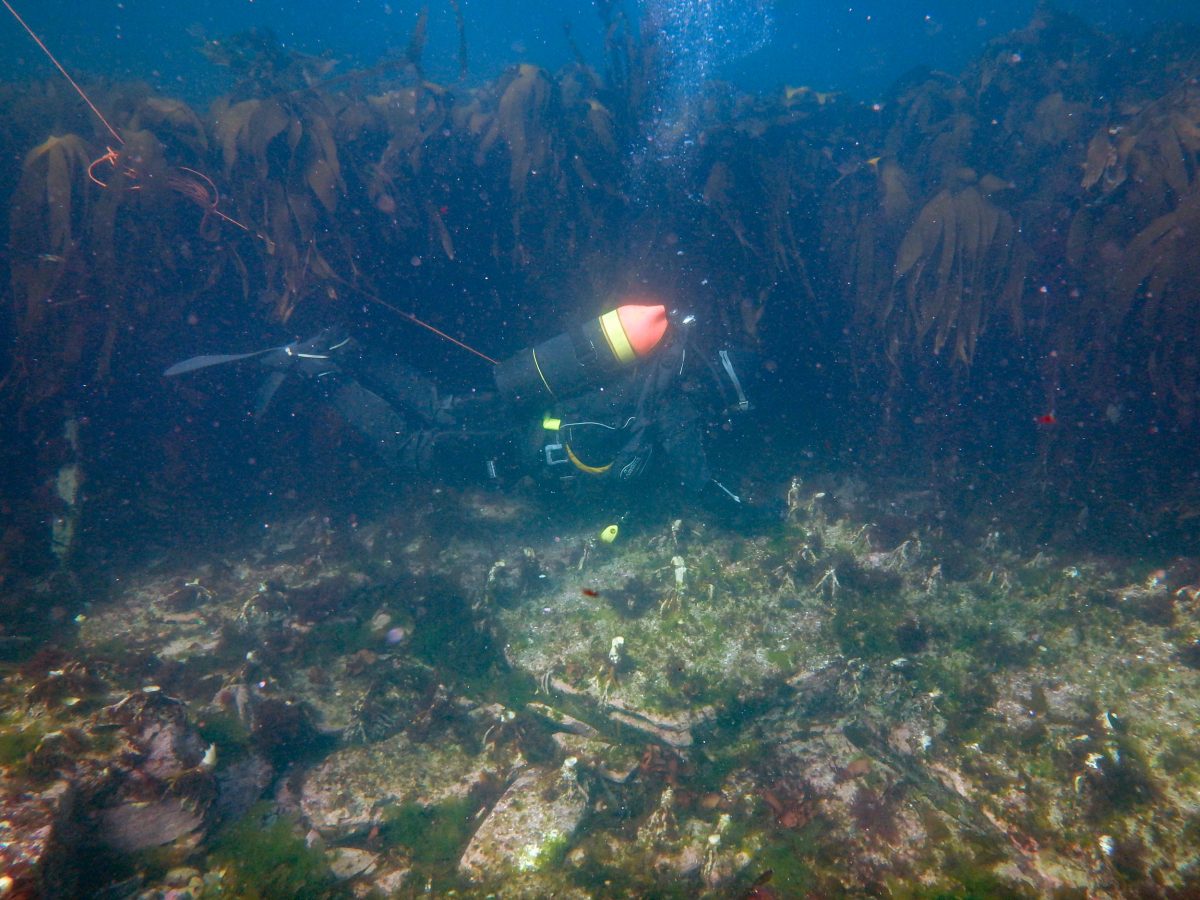
A diver from Dan Smale’s lab surveys the regeneration of disturbance plots where kelp has been removed. Photo courtesy of Dan Smale
Dobbie argues that the ban sidestepped Scotland’s regulatory process and prevented an informed decision. “That’s not the kind of country I grew up in or want to have for my grandchildren,” he says. “I want a country that evaluates evidence and then decides.” Others were uneasy about the ban, too. Smale opposed Marine Biopolymers’ proposal, but balked at a decision based on outcry rather than careful study. Some politicians expressed misgivings about the legislative hammer even as they voted it in.
Kelp dredging will now be possible only with another legislative amendment. But the door might one day open again: parliament is now reviewing existing kelp regulations, which could lead to more research on Scotland’s kelp and the sustainability of industrial harvests. Marine Scotland has already scheduled mechanical harvesting field trials on seaweed species that pass an initial environmental and socioeconomic screening process, starting in summer of 2020.
Gaining a robust understanding of the region’s kelp forests will be laborious but imperative as global harvests of wild kelp gallop ahead of research on impacts. Norway dredges hundreds of thousands of tonnes of hyperborea annually, while Chile, China, and Japan harvest local species in large quantities. The United Nations warns that over-exploitation, climate change, and pollution could all lead to declines in wild harvesting.
Despite the remaining uncertainties about mechanical harvesting in Scotland, there is still a chance that McLellan’s more comprehensive vision of sustainability will find its footing in Scotland. Shortly before I leave Ullapool, local Scottish Wildlife Trust conservationist Noel Hawkins takes me out on the Loch Broom. We pause on the uninhabited Isle Martin, owned and managed by a community trust, where a row of abandoned cottages is the only reminder of the herring industry that once thrived there. These days, it’s a bird sanctuary where volunteers maintain a small garden. Seaweed fertilizer covers the ground beneath the shrubs.
The boat Hawkins helms is called Mada-Chuain, meaning “ocean wolf”—the term for killer whale in Gaelic. The threatened language is slowly making a comeback in Ullapool and other parts of Scotland. McLellan doesn’t speak Gaelic, but her grandparents did—and now her son does, part of the new generation of native speakers built by immersive language programs in schools.
It’s a recovery curve echoed at every turn: hints of a Scotland that was nearly destroyed but is beginning to resurface. Beavers have been reintroduced in places, and there has been talk of bringing back lynxes and wolves. In the past few decades, the people of the Scoraig peninsula have steadily reforested the land. Along with the handful of Highlands communities that have bought their land from wealthy landowners and now manage it in community trusts, their vision of Scotland’s natural resources is one of shared ownership and shared benefit.
The loch is choppy and we launch into brief flight with each wave, drenched in freezing spray. From wide Annat Bay, An Teallach, a craggy mountain capped in cloud, dominates the view toward Ullapool. Long ago, that cloud cap prompted its own local myth: the mountain was the forge where the gods created the world, and it was from An Teallach that the god came down to deal Beinn Ghobhlach’s witch her doom.
As we navigate the south side of Loch Broom, Hawkins points out white-tailed eagles nesting on a stretch of forbidding cliffs. They’re one of a few breeding pairs to have returned to the region and had their first chick in 2014. Last year, divers spotted a large herring spawning ground in a nearby loch for the first time in decades. Patches of recovered forest dot the mountains. And the water is marked with telltale patches of navy—healthy kelp, offering a chance to tread carefully right from the start.

